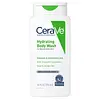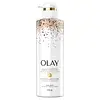What's inside
What's inside
 Key Ingredients
Key Ingredients

 Benefits
Benefits

 Concerns
Concerns

 Ingredients Side-by-side
Ingredients Side-by-side

Water
Skin ConditioningCocamidopropyl Betaine
CleansingPetrolatum
EmollientLauric Acid
CleansingSodium Cocoyl Glycinate
CleansingGlycerin
HumectantGlycine Soja Oil
EmollientUrea
BufferingStearic Acid
CleansingSodium Cocoyl Isethionate
CleansingSodium Hydroxypropyl Starch Phosphate
AbrasiveSodium Lauroamphoacetate
CleansingSodium Methyl Cocoyl Taurate
CleansingSodium Chloride
MaskingCeramide NP
Skin ConditioningCeramide AP
Skin ConditioningCeramide EOP
Skin ConditioningHyaluronic Acid
HumectantPhenoxyethanol
PreservativeGuar Hydroxypropyltrimonium Chloride
Skin ConditioningSodium Hydroxide
BufferingSodium PCA
HumectantOphiopogon Japonicus Root Extract
Skin ConditioningTetrasodium EDTA
Ethylhexylglycerin
Skin ConditioningSodium Lauroyl Lactylate
EmulsifyingPhytosphingosine
Skin ConditioningCholesterol
EmollientCarbomer
Emulsion StabilisingXanthan Gum
EmulsifyingWater, Cocamidopropyl Betaine, Petrolatum, Lauric Acid, Sodium Cocoyl Glycinate, Glycerin, Glycine Soja Oil, Urea, Stearic Acid, Sodium Cocoyl Isethionate, Sodium Hydroxypropyl Starch Phosphate, Sodium Lauroamphoacetate, Sodium Methyl Cocoyl Taurate, Sodium Chloride, Ceramide NP, Ceramide AP, Ceramide EOP, Hyaluronic Acid, Phenoxyethanol, Guar Hydroxypropyltrimonium Chloride, Sodium Hydroxide, Sodium PCA, Ophiopogon Japonicus Root Extract, Tetrasodium EDTA, Ethylhexylglycerin, Sodium Lauroyl Lactylate, Phytosphingosine, Cholesterol, Carbomer, Xanthan Gum
Water
Skin ConditioningSodium Trideceth Sulfate
CleansingSodium Chloride
MaskingPetrolatum
EmollientCocamidopropyl Betaine
CleansingHydrated Silica
AbrasiveTrideceth-3
EmulsifyingParfum
MaskingNiacinamide
SmoothingSaccharum Officinarum Extract
MoisturisingTheobroma Cacao Seed Butter
EmollientSodium Citrate
BufferingGuar Hydroxypropyltrimonium Chloride
Skin ConditioningCitric Acid
BufferingSodium Benzoate
MaskingXanthan Gum
EmulsifyingStearyl Stearate
EmollientDisodium EDTA
Sodium Hydroxide
BufferingGlyceryl Oleate
EmollientAcrylates/C10-30 Alkyl Acrylate Crosspolymer
Emulsion StabilisingEuphorbia Cerifera Wax
Jojoba Esters
EmollientMethylchloroisothiazolinone
PreservativeMethylisothiazolinone
PreservativeIron Oxides
Water, Sodium Trideceth Sulfate, Sodium Chloride, Petrolatum, Cocamidopropyl Betaine, Hydrated Silica, Trideceth-3, Parfum, Niacinamide, Saccharum Officinarum Extract, Theobroma Cacao Seed Butter, Sodium Citrate, Guar Hydroxypropyltrimonium Chloride, Citric Acid, Sodium Benzoate, Xanthan Gum, Stearyl Stearate, Disodium EDTA, Sodium Hydroxide, Glyceryl Oleate, Acrylates/C10-30 Alkyl Acrylate Crosspolymer, Euphorbia Cerifera Wax, Jojoba Esters, Methylchloroisothiazolinone, Methylisothiazolinone, Iron Oxides
Ingredients Explained
These ingredients are found in both products.
Ingredients higher up in an ingredient list are typically present in a larger amount.
Cocamidopropyl Betaine is a fatty acid created by mixing similar compounds in coconut oil and dimethylaminopropylamine, a compound with two amino groups.
This ingredient is a surfactant and cleanser. It helps gather the dirt, pollutants, and other impurities in your skin to be washed away. It also helps thicken a product and make the texture more creamy.
Being created from coconut oil means Cocamidopropyl Betaine is hydrating for the skin.
While Cocamidopropyl Betaine was believed to be an allergen, a study from 2012 disproved this. It found two compounds in unpure Cocamidopropyl Betaine to be the irritants: aminoamide and 3-dimethylaminopropylamine. High-grade and pure Cocamidopropyl Betaine did not induce allergic reactions during this study.
Learn more about Cocamidopropyl BetaineThis ingredient is derived from guar gum.
It is a conditioning ingredient, meaning it helps soften skin and hair.
Petrolatum is more commonly known as petroleum jelly. It is created by mixing waxes and mineral oils.
This ingredient is effective at reducing water loss by 99%. This is because it is an occlusive. Occlusives create a hydrophobic barrier on the skin to prevent evaporation. This property makes it great for hydrating dry skin.
Pro tip: Use occlusives, such as this ingredient, on damp skin for the best results.
The quality or origin of petrolatum is only known when disclosed by the brand. Most cosmetic petrolatum has gone through several purification stages.
Another benefit of occlusives is it protects your skin against infection or allergies.
Petrolatum may not be safe for fungal-acne. Studies show mineral oil / petroleum leads to the growth of M. Furfur, a type of yeast.
Learn more about PetrolatumChances are, you eat sodium chloride every day. Sodium Chloride is also known as table salt.
This ingredient has many purposes in skincare: thickener, emulsifier, and exfoliator.
You'll most likely find this ingredient in cleansers where it is used to create a gel-like texture. As an emulsifier, it also prevents ingredients from separating.
There is much debate on whether this ingredient is comedogenic. The short answer - comedogenic ratings don't tell the whole story. Learn more about comegodenic ratings here.
The concensus about this ingredient causing acne seems to be divided. Research is needed to understand if this ingredient does cause acne.
Scrubs may use salt as the primary exfoliating ingredient.
Learn more about Sodium ChlorideSodium Hydroxide is also known as lye or caustic soda. It is used to adjust the pH of products; many ingredients require a specific pH to be effective.
In small amounts, sodium hydroxide is considered safe to use. However, large amounts may cause chemical burns due to its high alkaline.
Your skin has a natural pH and acid mantle. This acid mantle helps prevent harmful bacteria from breaking through. The acid mantle also helps keep your skin hydrated.
"Alkaline" refers to a high pH level. A low pH level would be considered acidic.
Learn more about Sodium HydroxideWater. It's the most common cosmetic ingredient of all. You'll usually see it at the top of ingredient lists, meaning that it makes up the largest part of the product.
So why is it so popular? Water most often acts as a solvent - this means that it helps dissolve other ingredients into the formulation.
You'll also recognize water as that liquid we all need to stay alive. If you see this, drink a glass of water. Stay hydrated!
Learn more about WaterXanthan gum is used as a stabilizer and thickener within cosmetic products. It helps give products a sticky, thick feeling - preventing them from being too runny.
On the technical side of things, xanthan gum is a polysaccharide - a combination consisting of multiple sugar molecules bonded together.
Xanthan gum is a pretty common and great ingredient. It is a natural, non-toxic, non-irritating ingredient that is also commonly used in food products.
Learn more about Xanthan Gum